Hacienda, Russian River, Sonoma, California
HACIENDAS DEL RIO
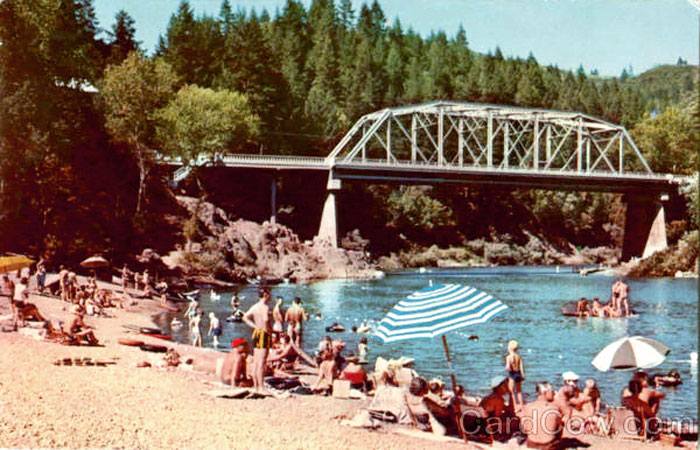
Hacienda Beach in the '60's.
Anthony's daughter, Minnie McPeak Meisner, became the owner of Cosmo, perhaps through inheritance and by purchasing shares from the other children. And in 1926, when W.S. "Duncan" Smith, part owner of the Rio Nido resort, and A.J. Froehlich who ran a tent camp in Rio Nido wanted to expand upon the popularity of Rio Nido, they incorporated as Hacienda, Inc. and purchased the Cosmo resort for $35,000, nearly half a million 2017 dollars. Their vision was to build a nine hole golf course and sell home sites around it. The name of the golf course would be The Russian River Golf and County Club. The community would be called Haciendas Del Rio The railroad promptly changed the sign on the station from "Cosmo" to read, "Hacienda." For better or for worse, this community has been called Hacienda ever since. The bridge that was referred to as the Russian River Bridge at Cosmo became the Hacienda Bridge. The gravel bar where Anthony McPeak swam as a child became Hacienda Beach.
Not so fast.
New clippings are showing that the train station sign didn't change from Cosmo to Hacienda. The train station sign changed from Cosmo to Camp Six.
New clippings are showing that the train station sign didn't change from Cosmo to Hacienda. The train station sign changed from Cosmo to Camp Six.
CAMP SIX
The earliest clipping I have that shows the usage of the term, Camp Six, is 1895, though it was still in use ten years later. I have little hard information on why this name change took place. I am going to suggest that it could have been that the Northwest Pacific Railroad wanted their stations to be named for communities, and not for a private business. By the late 1800s, there could have been people living in the area who wanted to establish an identity not tied only to Cosmo Farm. Why the name, "Camp Six?" A possible explanation is that Cosmo was considered the sixth stop. The list would have been Fulton, Trenton, Forestville, Mirabel Park, Green Valley and then Cosmo.
Note the instructions in this ad for Cosmo Farm from 1905.
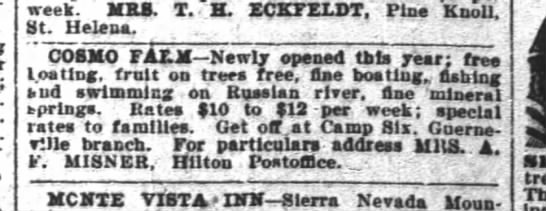
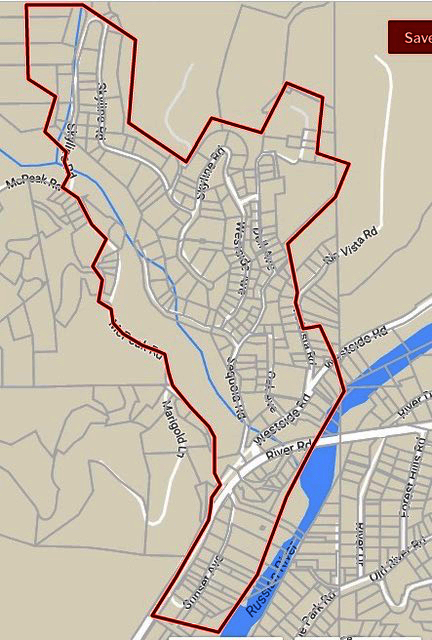
Haciendas Del Rio property border showing as a red line.
The golf course was built, and it was a great one. The new owners hired a Santa Rosa golf specialist to design the course, not the often credited, Alister Mackenzie who designed Northwest Golf Course. The landscaping was the creative work of Fred L. Moynahan of Healdsburg.
The commercialization of Cosmo Farm did not go unnoticed. The Sotoyme Scimitar (January 4, 1927) wrote:
"The McPeak ranch, introduced to the summer resort world some fifteen or twenty years ago as “Cosmo Farm” by Mr. and Mrs. A. F. Misener of Windsor, sold by them last year to Duncan Smith, a bay capitalist, has now become “Hacienda,” and it is to be developed by the establishment of an elaborate golf course, the erection of a hotel, and to be sub-divided into lots for summer homes for the rich and idle exclusively —all of which, of course, spells m-o-n-e-y in five or six figures."
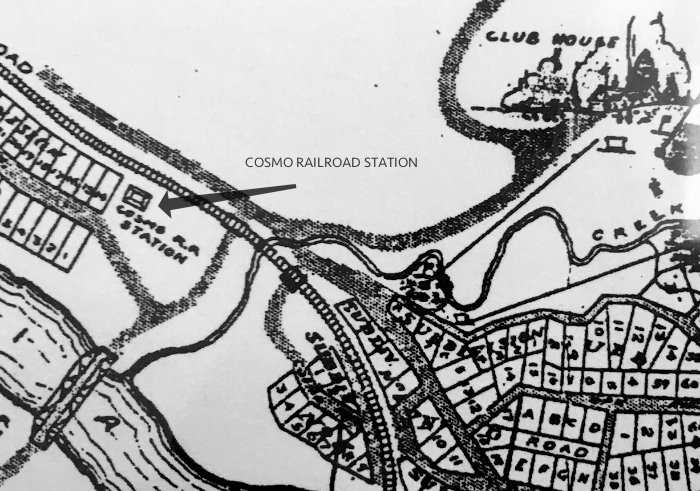
Hand drawn promotional map shows location of the railroad station as well as the summer bridge. This drawing would have been made around 1927 or 28.
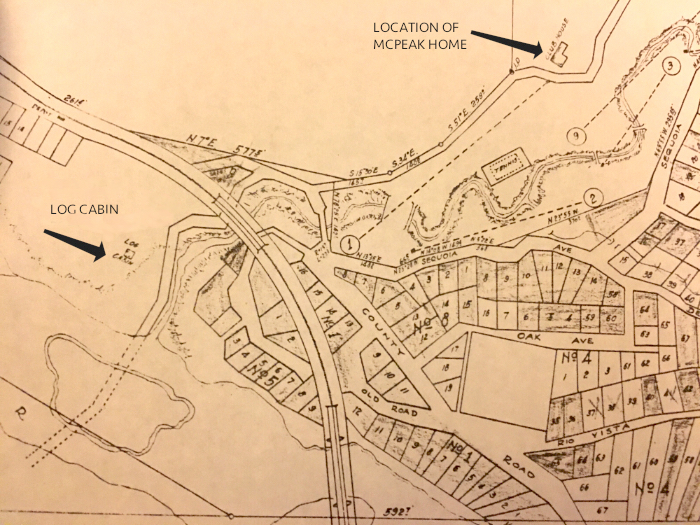
An official survey map. McPeak Road crosses under tracks and connects with summer crossing bridge.
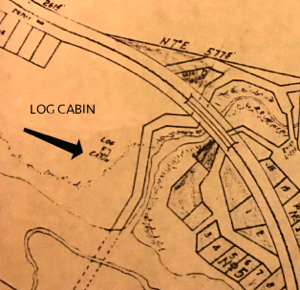
The log cabin was the sales office for Hacienda, Inc. It was constructed in 1926 of redwood the had been milled to look like logs. It was located on the road that crossed the river, soon to be the Hacienda Summer Crossing Bridge.
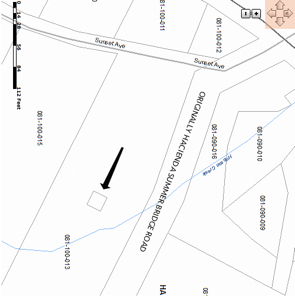
This is the county parcel map showing a square box location of or near the log cabin. There is a good chance that this is the location of a well that was commercially operated by George Hasek to provide water to the residents of Hacienda.
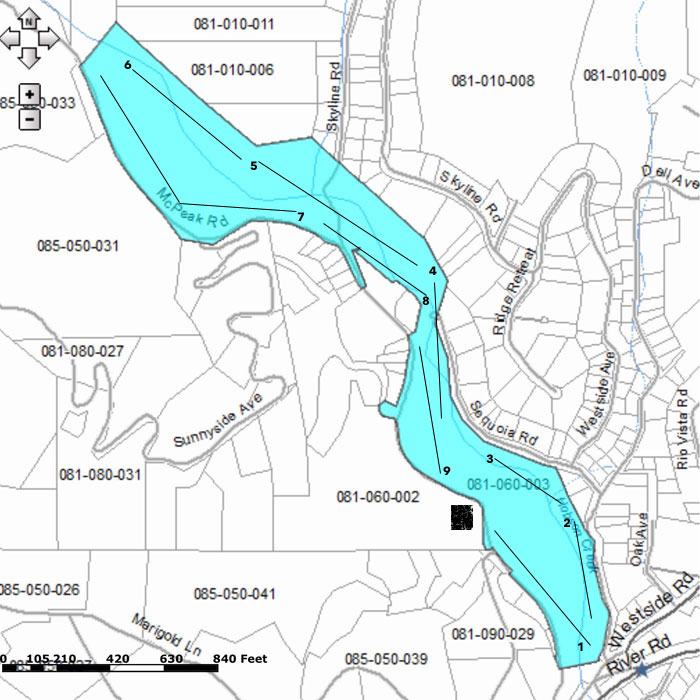
Visitors often ask me, "Where was the golf course." Here it is.
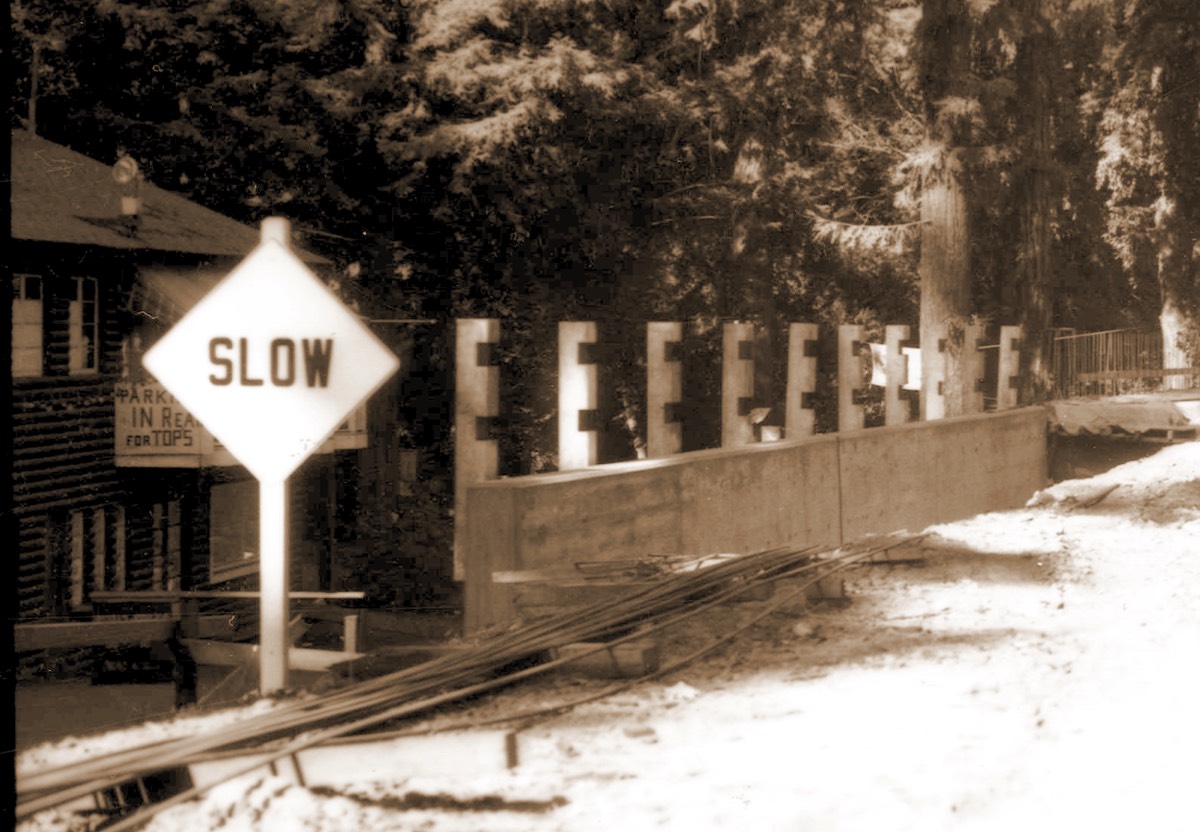
The Tops Club, here largely hidden behind a SLOW sign in 1950. TOPS was on the upper floor and on the bottom was a shop that had comic books, candy, and soft drinks.
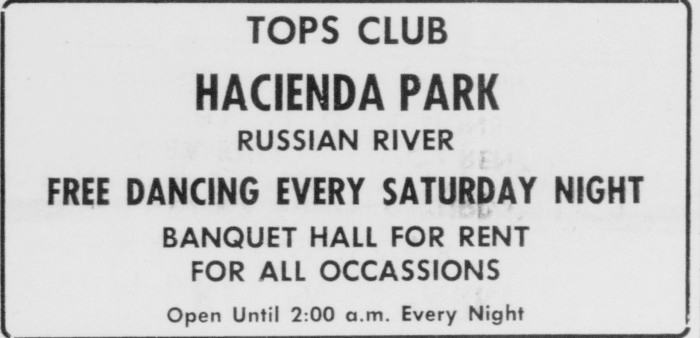
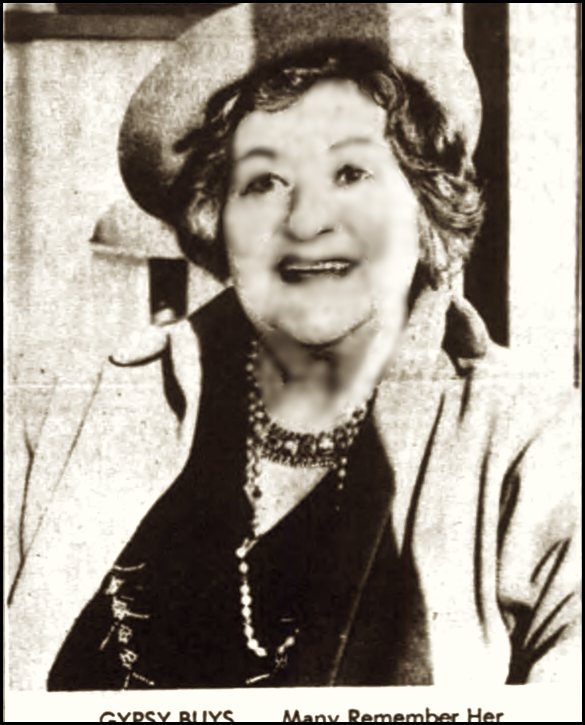
Tops Club in 1952 was owned by Gypsy Buys, an eccentric wealthy personality known for her fascination with Rudolph Valentino. Also, Gypsy Buys became notorious for her involvement in the Jaime Sandoval murder scandal in the 1960-70s.
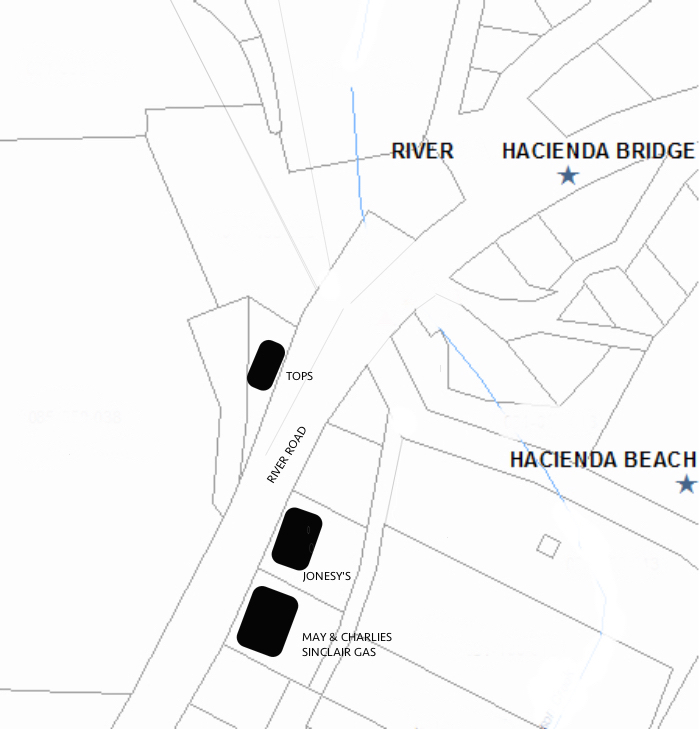
Tops Club, Jonesy's, and May & Charlie's gas station were where the kids hung out. Tops had music and alcohol, Jonesy's had snacks, and the gas station had burgers. Really good burgers.
Jonesy's, in the '80s, became a restaurant, Pomme de Terre, a bar / music venue named Sebastian's of Hacienda. After that it was The International Cafe, an internet cafe, and then a Charter School. In 2017 it is a private home.
The building apparently housed Arnolds Unfinished Furniture in the '50s.
May & Charlie's station is also a private home in 2017.
Tops assumed various uses as different owners to over the business. At one point is was a restaurant named Jim and Ann's Steak House, and downstairs was The Wagon Wheel. Eventually it became an empty run down shell which burned to the ground. In 2017, the parcel is vacant.
Jonesy's, in the '80s, became a restaurant, Pomme de Terre, a bar / music venue named Sebastian's of Hacienda. After that it was The International Cafe, an internet cafe, and then a Charter School. In 2017 it is a private home.
The building apparently housed Arnolds Unfinished Furniture in the '50s.
May & Charlie's station is also a private home in 2017.
Tops assumed various uses as different owners to over the business. At one point is was a restaurant named Jim and Ann's Steak House, and downstairs was The Wagon Wheel. Eventually it became an empty run down shell which burned to the ground. In 2017, the parcel is vacant.
Next to the links was the Hacienda Inn, with rooms, a restaurant and bar, and a spacious deck overlooking the manicured golf course. Years later the restaurant would become Skippy's, named for owner Al 'skip' Orsi, and be widely popular. The building, long abandoned, was torn down in 2017. More information on Skippy's can be found here.
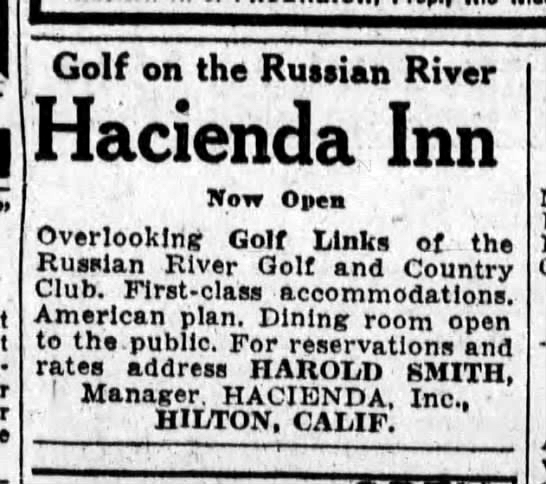
An ad in the Oakland Tribune.
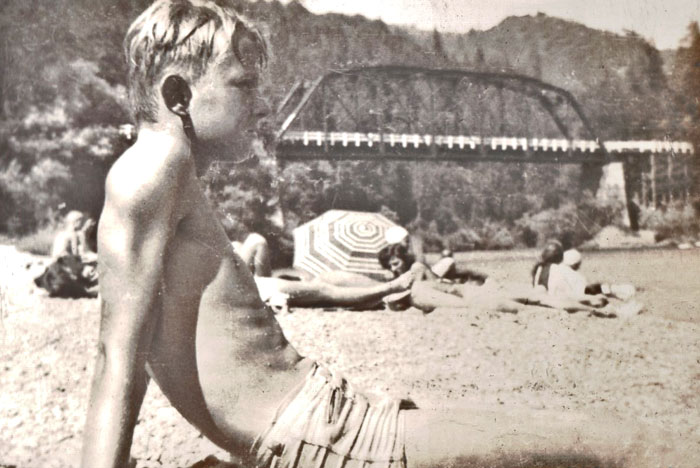
Harold Smith's, one of the founders of Hacienda, nephew Richard Iverson sunning on the Hacienda Beach. (Used with Richard Iverson's permission)
While everything seemed lovely and exciting, the reality was anything but. Prohibition arrived in 1920 and threw a wet blanket on the pleasures of living even beyond those associated with alcohol. The stock market crashed in 1929 and the entire country was thrown into a depression. Also, a few years before the sale of Cosmo, 1924, a large forest fire burned for three weeks and destroyed mills and acres of redwoods between Guerneville and the coast. It was a disaster for the mills and for the railroad which had been enjoying huge earnings from hauling lumber. It was also bad publicity for people considering a visit.
Haciendas Del Rio saw a way of making some money. In 1928 they sold rights to develop a gravel plant to Independent Gravel who owned other gravel plants on the Russian River. I'm not sure what happened because I don't think the plant was ever built. It would have been disastrous to the recreational aspect of Hacienda Beach.
Hacienda, Inc. constructed a summer bridge that allowed easier access for cars and busses coming from the Bay Area. Suddenly the railroad was not the favored way of getting to Russian River. The popularity of motorized vehicles also made it possible to go to other places for fun, like Lake Tahoe which suddenly boomed as a destination. While automobile access helped Hacienda attract guests, it also was helping kill the railroad.
The trestle approach to the Hacienda railroad bridge had degraded to the point where it was becoming unsafe, and the cost of repairing it was not realistic. The decision was made to phase out the railroad. The last train ran in 1935 and the glory days of the Russian River as a resort were coming to an end.
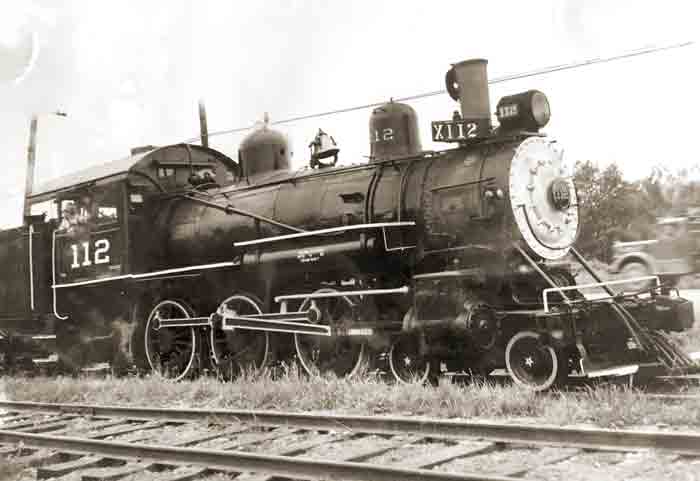
Engine number 112 was the final train to cross the Hacienda Bridge, November 14, 1935. People stood by the tracks as it passed with tears in their eyes. Everyone could see it was the end of an era.
Sonoma County purchased the train track right-of-way and the bridges from the Northwest Pacific Railroad in 1936 for $15,547.00 ($270,000 in 2017) with plans to convert the track right-of-way to a road. Two years later the conversion of the Hacienda train bridge to a one lane car bridge was celebrated. Sixty-two years had passed since the first train reached Cosmo.
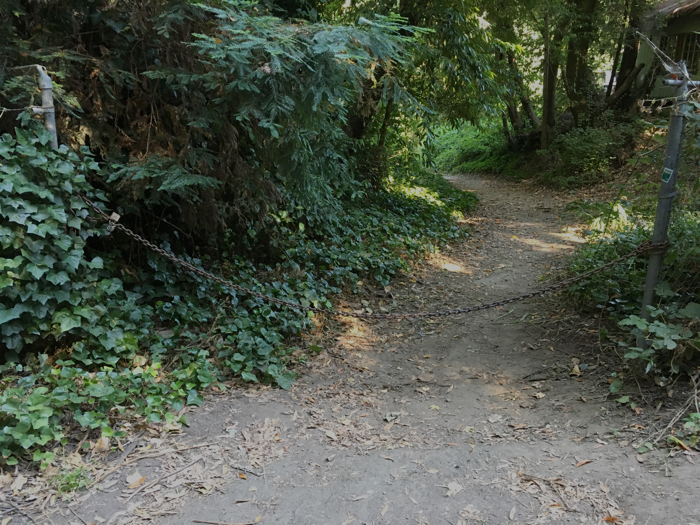
Today the road to the Hacienda Summer Bridge is just a chained off path to the river. This right-of-way, as well as where the road joined the Forest Hills side of the river, are still owned by Sonoma County.
Hacienda, Inc. was sold and while my records are sketchy, I have seen that in 1943 Hacienda was owned by Angelo F. Boles, who owned other resorts in the area. I seem to see that the IRS perhaps forced Hacienda, Inc into closing as a business around the end of the '60's. The Hacienda Improvement Association which has existed since 1939 and is still active in 2017, fought for, and won, the right to control the beach portion in 1969. A requirement from the sellers was that "the beach portion of the property herein conveyed as the 'Angelo F. Boles Memorial Beach' and grantee shall erect and permanently maintain hereafter an appropriate redwood plaque identifying said beach area by such name."
Here is that plaque.
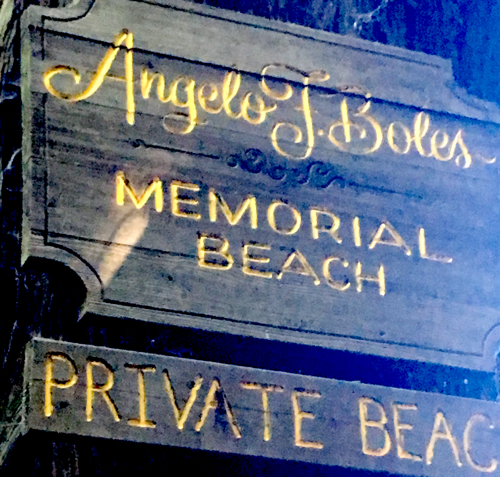
While commonly known as Hacienda Beach, we really should call it, Boles Beach.
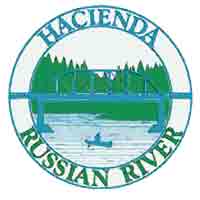
The Hacienda Improvement Association. http://haciendatown.org/
In 1969 the Hacienda Improvement Association acquired title to Hacienda Beach and members pay dues to take care of insurance and fees mostly involving the beach, but as an organization the Association gets involved in all aspects of community concerns.
Facebook: https://www.facebook.com/Hacienda-Improvement-Association-115464495162119/
In 1969 the Hacienda Improvement Association acquired title to Hacienda Beach and members pay dues to take care of insurance and fees mostly involving the beach, but as an organization the Association gets involved in all aspects of community concerns.
Facebook: https://www.facebook.com/Hacienda-Improvement-Association-115464495162119/
When Hacienda, Inc. failed, the golf course closed. However, Skippy’s did not close. It was open for several more decades, possibly into the early '90s. The last person to operate the restaurant was Don Kelso. He was a hoarder. A court order was required to clean up the collection of cars, boats, tractors, trucks, and other junk. He was unwilling, and probably unable, to comply, so after 6 years the County did it for him, and placed a lien on the property for the cost of the clean-up.
After Mr. Kelso, The Hacienda Inn, Skippy's, sat, a deteriorating shell of what it used to be. In 2016 it, and the surrounding acreage was purchased by a mortgage company, Cornerstone, and the structure was demolished a year later.
The next section, LANDMARKS, has more information and photos of Skippy's.
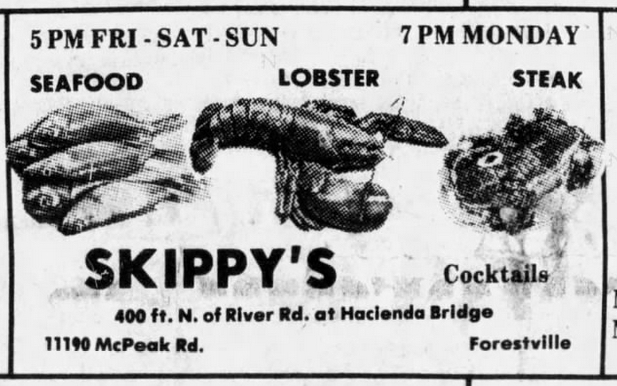
The Hacienda Bridge received the classification of "Historical" by Sonoma County in 1998. It also got a much needed seismic upgrade to strengthen the approach supports that did not alter the look of the bridge.
TIME LINE
1850 - California becomes a state. People still don't know why it is named California.
1850 - Santa Rosa has a general store and a branch of the delivery service, Wells Fargo
1852 - Mathew McPeak and family take the Oregon trail from Missouri and settle near Santa Rosa
1857 - Healdsburg is laid out as a town
1857 - Anthony McPeak purchases land beyond the Ridenhour Ranch. Marries Melissa Bell
1860 - Big Bottom (later Guerneville) is an active settlement on Russian River
1861 - Civil War starts
1862 - A legendary 200 year flood hits the entire Western USA. It predates record keeping.
1865 - Civil War ends
1868 - Santa Rosa incorporated as a town
1869 - Forestville established
1871 - Anthony McPeak buys the Hobson Farm and establishes Cosmo Farm Resort. The Korbel Brothers buy the old McPeak property
1876 - The railroad crosses the new bridge over Russian River into Cosmo
1879 - The largest Russian River flood in recorded history
1894 - Hilton Post Office certified
1906 - San Andreas Earthquake
1907 - The Hilton Brick Factory is built
1911 - Cosmo Farm gets electricity
1912 - Melissa Bell McPeak passes and is buried in McPeak Cemetery
1914 - World War I starts
1918 - World War I ends
1919 - Anthony McPeak passes and is buried in McPeak Cemetery
1920 - Prohibition starts
1922 - Wohler Bridge automobile bridge built across Russian River.
1926 - Cosmo Farm sold to Hacienda, Inc. to establish a subdivision of summer houses, known as Haciendas del Rio. Hacienda Inn hotel, restaurant and golf course are built. It is named The Russian River Golf and Country Club
1929 - Stock market crashes and the depression era starts
1933 - Prohibition ends
1935 - Train service to the river ends. Golden Gate Bridge opens.
1937-38 - The railroad bridge over Russian River is converted on a one-lane automobile bridge
1939 - World War II starts. Hacienda Improvement Association founded
1945 - World War II ends
1947 - Hacienda Bridge remodeled into a two-lane automobile bridge. Hobson Creek Bridge is built replacing the train trestle
1969 - Hacienda, Inc. transfers ownership of the beach to the Hacienda Improvement Association
2017 - Hacienda Inn / Skippy's is demolished.
1850 - Santa Rosa has a general store and a branch of the delivery service, Wells Fargo
1852 - Mathew McPeak and family take the Oregon trail from Missouri and settle near Santa Rosa
1857 - Healdsburg is laid out as a town
1857 - Anthony McPeak purchases land beyond the Ridenhour Ranch. Marries Melissa Bell
1860 - Big Bottom (later Guerneville) is an active settlement on Russian River
1861 - Civil War starts
1862 - A legendary 200 year flood hits the entire Western USA. It predates record keeping.
1865 - Civil War ends
1868 - Santa Rosa incorporated as a town
1869 - Forestville established
1871 - Anthony McPeak buys the Hobson Farm and establishes Cosmo Farm Resort. The Korbel Brothers buy the old McPeak property
1876 - The railroad crosses the new bridge over Russian River into Cosmo
1879 - The largest Russian River flood in recorded history
1894 - Hilton Post Office certified
1906 - San Andreas Earthquake
1907 - The Hilton Brick Factory is built
1911 - Cosmo Farm gets electricity
1912 - Melissa Bell McPeak passes and is buried in McPeak Cemetery
1914 - World War I starts
1918 - World War I ends
1919 - Anthony McPeak passes and is buried in McPeak Cemetery
1920 - Prohibition starts
1922 - Wohler Bridge automobile bridge built across Russian River.
1926 - Cosmo Farm sold to Hacienda, Inc. to establish a subdivision of summer houses, known as Haciendas del Rio. Hacienda Inn hotel, restaurant and golf course are built. It is named The Russian River Golf and Country Club
1929 - Stock market crashes and the depression era starts
1933 - Prohibition ends
1935 - Train service to the river ends. Golden Gate Bridge opens.
1937-38 - The railroad bridge over Russian River is converted on a one-lane automobile bridge
1939 - World War II starts. Hacienda Improvement Association founded
1945 - World War II ends
1947 - Hacienda Bridge remodeled into a two-lane automobile bridge. Hobson Creek Bridge is built replacing the train trestle
1969 - Hacienda, Inc. transfers ownership of the beach to the Hacienda Improvement Association
2017 - Hacienda Inn / Skippy's is demolished.